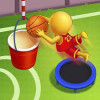Basket-Ball
About Basket-Ball
Basketball is a thrilling and dynamic sport that has captured the hearts of millions around the world. Played on a rectangular court with a hoop at each end, the game is a fast-paced and exciting competition that combines athleticism, teamwork, and strategy. Here, we'll explore the basics of basketball, its history, and what makes it such a beloved sport.
History:
Basketball was invented by Dr. James Naismith in December 1891 in Springfield, Massachusetts, USA. Naismith, a physical education instructor, created the game as an indoor activity to keep his students active during the winter months. He wrote down 13 basic rules and hung a peach basket at each end of the gymnasium as the goals. The objective was simple: throw a soccer ball into the opposing team's basket to score points. This simple concept laid the foundation for one of the world's most popular sports.
Basics of the Game:
Basketball is typically played with two teams, each consisting of five players on the court at any given time. The primary objective is to score points by shooting the ball through the opponent's hoop while preventing them from doing the same to your team's basket. Here are some key elements of the game:
Scoring: Teams earn points by making field goals (two or three points depending on the distance from the hoop) and free throws (one point each). Three-point shots are taken from beyond the arc, a designated line that's farther from the basket.
Dribbling: Players use their hands to dribble the ball (bounce it while moving) to advance it up the court. Dribbling is a fundamental skill that allows for ball movement while maintaining possession.
Passing: Teams work together to move the ball strategically. Passing allows for rapid ball movement, opening up scoring opportunities and keeping the defense on its toes.
Defense: Teams must defend against their opponents to prevent them from scoring. This involves blocking shots, stealing the ball, and forcing turnovers.
Shot Clock: In professional basketball leagues, there's a shot clock that limits the time a team has to take a shot (typically 24 seconds). This ensures an up-tempo, exciting style of play.
Positions: Players assume various positions, such as point guard, shooting guard, small forward, power forward, and center, each with specific roles and responsibilities on the court.
Substitutions: Teams can make substitutions during stoppages in play, allowing fresh players to enter the game.
Popularity:
Basketball's popularity has grown steadily over the years, becoming a global phenomenon. The National Basketball Association (NBA) in the United States is one of the most-watched and lucrative professional sports leagues worldwide. The game's appeal extends to college basketball, international competitions (like the Olympics and FIBA World Cup), and even street basketball played on outdoor courts around the world.
Skills and Athleticism:
Basketball demands a wide range of skills and attributes from its players. Speed, agility, strength, and endurance are essential physical qualities. Additionally, players need excellent hand-eye coordination, shooting accuracy, passing precision, and the ability to make split-second decisions on the court.
Teamwork:
One of the most beautiful aspects of basketball is its emphasis on teamwork. Successful teams rely on coordinated plays, unselfish passing, and effective communication. The chemistry between players often defines a team's success.
In conclusion, basketball is much more than just a game; it's a global cultural phenomenon that brings people together from all walks of life. It showcases athleticism, strategy, and teamwork while providing endless entertainment for fans. Whether played on a neighborhood court or in a professional arena, basketball continues to inspire and captivate people around the world
How to play
Using Mouse and Keyboard
























































